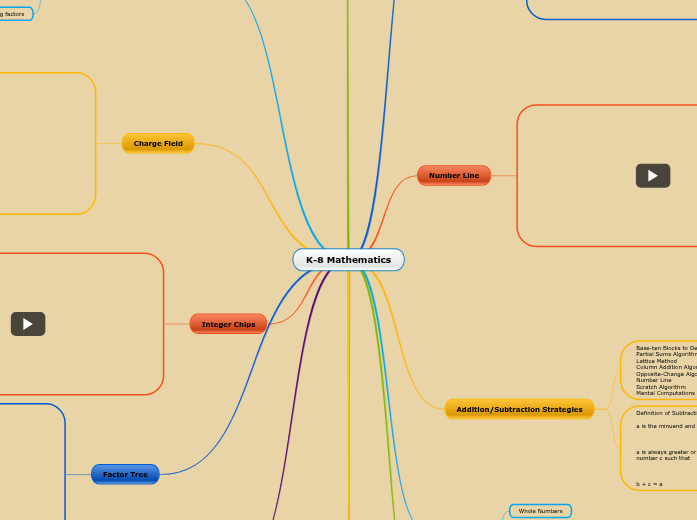K-8 Mathematics
GCF and LCM
Number Line
Addition/Subtraction Strategies
Base-ten Blocks to Develop the Standard Algorithm
Partial Sums Algorithm
Lattice Method
Column Addition Algorithm
Opposite-Change Algorithm
Number Line
Scratch Algorithm
Mental Computations
Definition of Subtraction of Whole Numbers:
a is the minuend and b is the subtrahend
a is always greater or equal to b, a - b is the unique whole number c such that
b + c = a
Integers
Whole Numbers
0
Negative numbers
Properties of Multiplication
Closure property of multiplication of whole numbers: a and b,
a X b is a unique whole number
Cumulative Property: a and b, a X b = b X a
Associative Property: (a X b) X c= a X ( b X c)
Identity Property: aka multiplicative identity. There is a unique whole number 1.
Multiplication Property of 0
Distributive property of multiplication over addition
Distributive Property of multiplication over subtraction
Properties of exponents
Bases
Base 10
Multiply bases
Divide Bases
Add and Subtract Bases
Converting bases
Multiplication/Division Strategies
Remainders
Repeated Subtraction
Repeated Subtraction Models: 24 - 8= 16; 16 - 8 = 8; 8 - 8 = 0. (subtracted, three 8’s)
24/8 = 3
Missing factors
Charge Field
Integer Chips
Factor Tree
Greatest Common Divisor/Factor and Least Common Multiple:
The GCD/GCF of two whole numbers a and b, not both 0, is the greatest whole number that divides both a and b.
Prime and Composite Numbers Definitions:
Prime numbers: Have exactly two whole divisors, 1 and themselves.
Composite numbers: Any whole number greater than 1 that has other whole number factors other than 1 and itself.
Prime factorization: is a factorization containing only prime numbers
